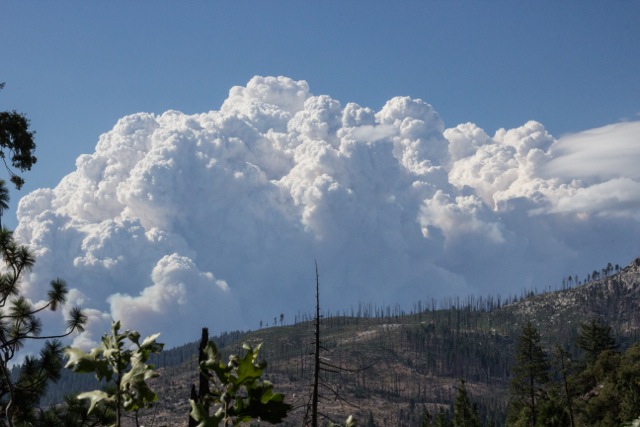You can see the latest data on the water level at Hetch Hetchy at this California Department of Water Resources link.
Update: 1 p.m. The latest from AP:
Containment of the Rim Fire more than doubled to 15 percent, although it was within a mile of Hetch Hetchy Reservoir, the source of San Francisco’s famously pure drinking water, officials said Monday.
“Obviously, it’s the water supply of the city of San Francisco, so we’re paying a lot of attention to that,” said Glen Stratton, an operations section chief on the fire.
The fire, which has grown to 234 square miles in size, also posed a threat to giant sequoias in Yosemite National Park. Crews were using sprinklers and lighting fires to clear brush, though the fire remained several miles from the massive trees, Stratton said.
Julie Hutchinson, battalion chief for Cal Fire in Riverside, said on KQED’s “Forum” this morning that the weather is the wild card in fighting the fire. “A wind shift in any direction can cause the fire to make runs in the direction that the wind is pushing it,” she said.
Also on on “Forum” this morning, San Francisco Public Utilities Commission General Manager Harlan Kelly said that the fire’s close proximity to Hetch Hetchy has not affected the ability to deliver water and power to meet the city’s needs. But he also said the agency was concerned about the ash produced by the fire that would eventually work its way into the water supply. More from AP on this aspect of the story …
Ash from the 234-square-mile fire has been falling on the reservoir, but so far hasn’t sunk far enough into the lake to reach intake pumps, Kelly said. Water quality remained good on Monday.
San Francisco gets 85 percent of its water from Hetch Hetchy as well as power for municipal buildings, the international airport and San Francisco General Hospital.
Kelly said on “Forum” that two of the three area plants used to generate power for the city have been taken offline. The remaining plant is producing less than a third of the power the city typically needs, he said, and power purchased on the open market is being used to make up the gap.
While Berkeley’s Tuolumne Family Camp was destroyed by the fire (info on refunds at the city of Berkeley’s website), San Francisco Rec & Park is reporting that the city’s Camp Mather site has sustained only minor damage. The Strawberry Music festival, however, scheduled for Aug. 29 to Sept. 2 at the camp, has been canceled.
As far as Yosemite National Park goes, the National Park Service says that as of 9:30 a.m. most of the park was not affected and is “relatively smoke free.” However, there are multiple closures of roads, campsites, trails and other attractions. Look at the National Park Service’s Rim Fire update page to find out what those are.
Meanwhile, the White House announced today that President Obama had called Gov. Jerry Brown for an update on the fires. Brown got his own briefing at a fire base camp today. Said Brown …
In other fire news, some evacuated residents from communities like Pine Mountain Lake are now returning. Fire officials say crews defended the town with a fire break that slowed the spread of the blaze. Maggie Dowd, a Groveland district ranger for the Stanislaus National Forest, said residents had done a lot to minimize damage from fires by limbing trees and clearing brush around their homes.
“I live in Pine Mountain Lake,” Dowd said, “and as a resident we are expected to do defensible space every year. We have a certain period of time to do that, and if we don’t, then we are fined. And I think that over the past couple of years they’ve had a lot of success with residents, and if fire was to come to that larger community it wouldn’t have engulfed it as it has in other populations.”
Monday, 8:10 a.m.: Fire officials say the fire has now burned just under 150,000 acres. That moves the Rim Fire up to No.13 on Cal Fire’s list of the biggest fires in state history. The blaze is also now the biggest recorded in the Sierra Nevada since at least the 1930s, the earliest date on the Cal Fire list. The state fire agency warned in an advisory early this morning that conditions today will continue to be tough: “Winds again today will pose a challenge with gusts of 26 mph out of the south, pushing the fire further to the northeast.”
The good news this morning: Cal Fire says containment on the fire doubled this morning from 7 percent to 15 percent.
